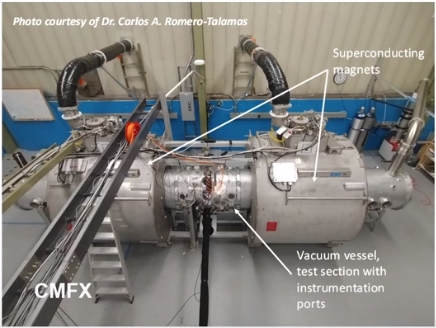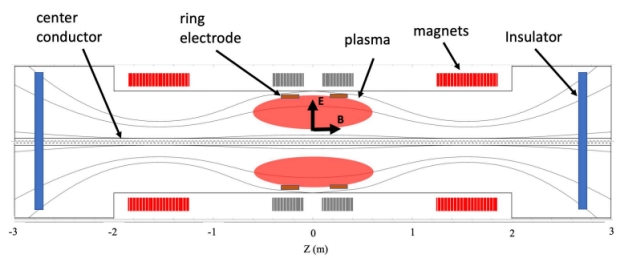I want to drop back to fusion propulsion at this point, as it bears upon the question of a Solar System-wide infrastructure that we looked at last time. We know that even chemical propulsion is sufficient to get to Mars, but clearly, reducing travel times is critical if for no other reason than crew health. That likely puts the nuclear thermal concept into play, as we have experience in the development of the technology as far back as NERVA (Nuclear Engine for Rocket Vehicle Application), and this fission-based method shows clear advantages over chemical means in terms of travel times.
It’s equally clear, though, that for missions deep into the Solar System and beyond, the high specific impulse (ISP) enabled by a theoretical direct fusion drive sets the standard we’d like to meet. In his presentation at the Interstellar Research Group’s Montreal symposium, Jerry Carson discussed the ongoing work at the University of Maryland on creating fusion conditions using deuterium/deuterium (D/D) and deuterium/tritium (D/T) fuel with centrifugal mirror confinement. D/T fusion will likely drive our first fusion engines, but its higher neutron flux will spotlight the advantages of helium-3 when the latter becomes widely available, as shielding the crew on a fusion-powered spacecraft will be a critical factor.

Image: The Centrifugal Mirror Fusion Experiment at the University of Maryland at Baltimore (principal investigator Carlos Romero-Talamás, University of Maryland, Baltimore County). The plan is to achieve fusion conditions (D/D) by 2025. Credit: UMD.
Let’s dig into the centrifugal mirror (CM) concept. The beauty of plasma is that it is electrically conductive, and hence manageable by magnetic and electric fields. Hall thrusters use plasma (though not fusion!), as do concepts like Ad Astra’s VASIMR (Variable Specific Impulse Magnetoplasma Rocket). In a centrifugal mirror, the notion is to confine, compress and heat the plasma as it is spun within a fusion chamber, as opposed to the perhaps more familiar compression methods of inertial fusion, or the magnetic field structures within tokamaks. Carson argues that the CM makes for a more compact reactor and greatly reduces radiation and momentum loss.
The Maryland work implements this effect using magnetic ‘mirrors’ to create the rapid spin that imposes radial and axial forces on the plasma, confining it into a ‘well’ where fusion can be attained. The fuel is bouncing back and forth along the lines of force between the two magnets, a method first explored in the 1950s, when research indicated that mirrors of this kind are leaky and cannot maintain the plasma long enough to ignite fusion. Carson said that it is the addition of an electric field via a central electrode in the UMD design that spins the ‘doughnut’ around its axis, so that the plasma is held in place both axially as well as radially. The basic diagram is below.

Image: Centrifugal mirror confinement of a high energy plasma. Credit: UMD.
The ongoing work at Maryland grows out of an experimental effort in the 2000s that has led to the current Centrifugal Mirror Fusion Experiment (CMFX). The latter is designed with terrestrial power generation in mind, so we are talking about adapting a power-generating technology into a spacecraft drive. To do that, we fire up a centrifugal mirror fusion reactor in tandem with warm plasma (likely a reservoir of hydrogen, though other gasses are possible), so that high-energy fusion products escape the reactor downstream and deposit their energy in the plasma, causing it to expand as it passes through a magnetic nozzle to produce thrust. The reactor also uses energy leaving the upstream mirror to continue its own operations.
A direct fusion drive of this kind could, Carson said, make the round trip to Mars in 3 months, and reach Saturn in less than three years, a sharp contrast to nuclear electric methods. Even nuclear thermal methods would take over a year to make the Mars mission. Looking further out, the Uranus Orbiter and Probe (UOP), which is being considered as a flagship mission for the upcoming Decadal Survey, would make for a 12 year journey using chemical propulsion and a gravitational assist at Jupiter, while DFD-CM in these specs could do a considerably larger mission to more distant Neptune in as little as 3 years. A second generation Interstellar Probe (50 years to the heliopause in the NASA concept) could reach 1000 AU in 30-35 years using DFD-CM.
We’re not quite through with the University of Maryland, because Carson’s colleague Tom Bone has been analyzing a unique way to take advantage of otherwise problematic bremsstrahlung radiation, which complicates foperations with various kinds of fusion fuels. I’ll run through that work in the next post. Turning this challenging radiation into usable energy is conceivably a possibility, but requires fuel other than the deuterium/tritium combination examined for the DFD-CM drive. Bone’s choice is intriguing, to say the least, but more about this next time.



My impression of the talk is that this technology while older than Helicity’s approach is at an earlier level of development. It isn’t even clear that this will work – at least the speaker was being honest and not hyping the technology.
Is there something I’m missing concerning the potential of this approach that makes it attractive or is this part of the “let’s support many different approaches and see which works or proves the best”?
Has anyone tried do confinement at a macromolecular level? To illustrate what I’m daydreaming (I haven’t the foggiest notion if it’s conceivable), picture a block of hexagonal boron nitride with all the rings lined up from each layer to the next, apart from switching the Bs and Ns. ( https://www.researchgate.net/figure/Crystal-structure-of-hexagonal-boron-nitride_fig4_311927923 ) If you could shoot a fast beam of protons through the thing, and if you could get most of them to align themselves dead center in one of the hexagonal spaces, and then you had one final layer of BN that was exactly misaligned to position its boron-15 nuclei directly in line with the center of the hole… Is it conceivable to do anything of that general description to make most collisions turn out to be direct hits?